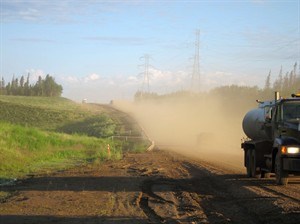
The untreated road at MacKay River is shown in this undated handout photo. Canada’s largest energy company enlisted the help of General Electric to get its dust problem under control using a glue of sorts to bind the particles together. THE CANADIAN PRESS/HO-Suncor/GE
February 02, 2014 - 3:00 AM
CALGARY - The dust clouds made it difficult to see and breathe as the big trucks rumbled along access roads at Suncor Energy Inc.'s MacKay River oilsands site.
Suncor's traditional dust control strategy of spraying water from a truck just wasn't working. In fact, it was an act of futility. On a hot summer day, the liquid would evaporate within 15 minutes.
So Canada's largest energy company (TSX:SU) enlisted the help of General Electric to get its dust problem under control using a glue of sorts to bind the particles together.
The result has been smoother, safer roads at its operations in northeastern Alberta, along with reductions in water and fuel use.
Gwen Morgen says when she took on the job of maintenance co-ordinator at MacKay River in 2011 she knew something had to change.
"I realized very quickly that this was not sustainable and we also were not getting the results that we were wanting in terms of performance."
In 2012, the company tested out the new method, which uses a byproduct of pulp and paper manufacturing to make the dirt stay put.
"The results were quite outstanding, actually. We were pleasantly surprised," said Morgen.
The organic and biodegradable compound was used throughout the entire site in 2013 and Morgen says she's had rave reviews from staff on site.
"They love it. It makes the roads so much smoother," she said.
The partnership involves more than GE just selling the dust-busting glue to Suncor. The two have worked out a dust control program which also includes road maintenance tailored to Suncor's specific needs.
"We actually go there, look at their roads, look at their conditions of the material on the road bed, look at their traffic, their weather conditions and then we develop a program," said Jeniffer Brown, GE's global lead product applications specialist.
GE has a business unit dedicated to dust control at industrial sites around the world, including mines and power plants.
The old water-spraying technique, in addition to not being particularly effective, can also damage roads, said Brown.
"If you go on an unpaved road during very heavy rainy season, it creates a lot of potholes, so you create a safety issue on the road," she said.
"So watering frequently generates those problems as well."
Now, with less wear and tear on the roads, repairs involving heavy equipment like graders need to be done less frequently, Brown added.
In the past, Suncor would send an average of five water trucks a day along its roads to keep the dust down. Now, only one truck is needed.
The result has been an 85 per cent reduction in water use for this purpose, saving 136 million litres of water annually. It's also cut diesel use by 70,000 litres, resulting in 190 fewer tonnes of carbon dioxide from entering the atmosphere.
The partnership with GE is part of a wider Suncor effort to reduce water use at its oilsands operations — one of the major environmental concerns associated with that type of energy development.
According to the Pembina Institute, an environmental think-tank, producing one barrel of bitumen from an oilsands mine requires 2.4 barrels of fresh water, after accounting for recycled water.
Suncor is expecting to produce between 400,000 and 430,000 barrels of crude per day from the oilsands this year.
Suncor has been working on cutting the volume of wastewater that sits in enormous tailings ponds, which also include sand, clay and residual bitumen. About a year ago, it began sending 10,000 cubic metres per day of tailings water from its base oilsands mining operations to be used at its steam-driven Firebag project, according to its 2013 Report on Sustainability.
A $150-million wastewater treatment facility is also expected to start up this year, further reducing the amount of water it needs to draw from the Athabasca River.
Simon Dyer of the Pembina Institute said he's urging the Alberta government to put regulations in place that would prevent energy companies from withdrawing water from the Athabasca River during low-flow times.
"Suncor has done good work in terms of lowering its water use per barrel," he said. "But from a cumulative perspective, the amount of water withdrawn from the river is going to continue to increase as a result of increased production with all the industry there."
Follow @LaurenKrugel on Twitter
News from © The Canadian Press, 2014